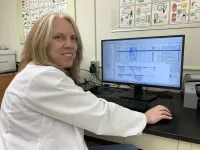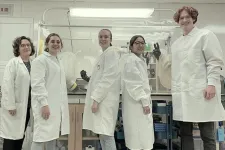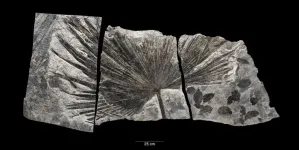(Press-News.org)
A new way of looking at tooth enamel could give scientists a path to deeper understanding of the health of human populations, from the ancient to the modern.
The method, published this week in the Journal of Archaeological Science, examines two immune proteins found embedded in human tooth enamel: immunoglobulin G, an antibody that fights infection, and C-reactive protein, which is present during inflammation in the body.
“These proteins are present in tooth enamel, and they are something we can use to study the biological and potentially the emotional health of past human populations,” said Tammy Buonasera, an assistant professor at the University of Alaska Fairbanks and lead author of the paper. “Analysis of immune proteins in enamel has not been done before and this opens the door to studying disease and health in the past in a more targeted way than we can today.
The study began when Buonasera was a research associate at the University of California, Davis. She and collaborators, including representatives from local Indigenous tribes, tested for the presence and amount of the proteins in tooth enamel from three groups of people:
Ancestral Ohlone people from a mission outpost dating to the late 1700s and early 1800s in the San Francisco Bay Area. Their skeletons were inadvertently discovered during a 2016 construction project in the area. Tribal descendants gave permission for their teeth to be used in the study.
European settlers from the late 1800s buried at a San Francisco city cemetery.
Modern-day military cadets who donated wisdom teeth.
The research team then cross-referenced the levels of the two proteins with the known history and experiences of each of the populations. Native peoples in the California mission system experienced high rates of mortality, intense stress and introduced infectious diseases. European settlers from the 1800s had shorter lifespans than present-day populations but, as a group, were assumed to have experienced lower degrees of stress and disease than the Ohlone group. It was assumed that the present-day military cadets experienced better health and nutrition than both archaeological groups.
The researchers found a close correspondence between evidence for high levels of stress and disease in the Indigenous population and high levels of the two proteins in their teeth. Protein levels were much higher than those in the other two groups tested.
“We see certain individuals, especially children, with very high levels of immunoglobulins, which the body uses to battle disease, and C-reactive protein, which people produce when they are under stress,” said Jelmer Eerkens, an anthropology professor at University of California, Davis and one of the corresponding authors on the paper. “It’s heartbreaking to think about children who may have lost their parents and family to disease, were thrown into a new cultural environment they didn’t understand, and how it affected their well-being.”
Buonasera said this new way of looking at teeth could allow scientists a more detailed look at historical and prehistoric human experiences, for several reasons.
The first is that teeth form during different windows in a human’s development, starting in utero and continuing through late adolescence or early adulthood. That growth over time in each tooth is analogous to the rings in a tree.
“So, it has the potential to provide us with a record — from birth to early adulthood — of a person’s health status,” Buonasera said.
Second, immune proteins within tooth enamel could provide more specific information about health than scientists can get from looking at structural changes to bone or teeth. Many illnesses do not leave a visible trace on the skeleton, while proteins in teeth may record responses to illness or inflammation.
Finally, tooth enamel tends to degrade much slower than other tissues in the body. That means there’s potential to learn from the proteins in the teeth of ancient humans, providing a timeline of human wellness that stretches back thousands of years.
Beyond gaining new insight into the lives of ancient humans, the method has potential to fuel discoveries about the effects of stress, disease and lifestyle on modern humans as well, she said.
“Without trying to overstate things too much, looking at stresses and immune responses in past populations could provide points of comparison with modern lifestyles that can be especially valuable because you have that depth of time,” Buonasera said.
In addition to being the first to examine serum proteins trapped in enamel, the study is also innovative because of the accuracy the new method provides, said Glendon Parker, an adjunct associate professor at UC Davis and one of the co-authors of the paper.
“We see the approach Tammy and her team have taken to be relevant in many contexts, for this and other questions,” Parker said. “These new tools will give us further insight into the lives of past peoples. It is an exciting time for bio-anthropology as these tools become available.”
NOTE TO EDITORS: Photos are available for download from the UAF news website. Access the full text of the paper on the journal's website.
END
Researchers discovered a drug that safely and effectively helped cancer patients when they suffered from cachexia (ku-KEK-see-uh), a common condition related to cancer that involves weight loss and muscle wasting.
The results of the randomized phase 2 clinical trial, which included187 individuals who experienced cachexia with lung, pancreatic, or colorectal cancer, were reported in the New England Journal of Medicine on Sept. 14, 2024. Richard Dunne, MD, MS, a Wilmot Cancer Institute oncologist and cachexia expert was part of the large group of investigators ...
Blanca Barquera's investigation into the energy-generating processes of Bacteroides, the most abundant member of the gut microbiome, and their impact on our well-being holds the promise of significant advancements in human health. Barquera is a professor at Rensselaer Polytechnic Institute in the Departments of Biological Sciences and Chemistry and Chemical Biology.
In recent years, it has become increasingly clear that an unhealthy gut is more than just a source of digestive troubles. A healthy ...
Jeffrey Elam, senior chemist, Distinguished Fellow, and founder of the atomic layer deposition (ALD) research program at the U.S. Department of Energy’s Argonne National Laboratory, was named as a fellow of the Electrochemical Society (ECS), which focuses on advancing theory and practice at the forefront of electrochemical and solid-state science and technology. Elam, who has been with the lab since 2002, has been a trailblazer in thin film coating science and technology for over 20 years, ...
Oregon Health & Science University researchers have found that despite legislation in 19 states requiring insurers to cover a 12-month supply of contraception, patients aren’t receiving a year’s worth of their prescription; most receive just three months or less.
Their study recently published in the journal JAMA Health Forum shows that policies requiring coverage of a 12-month supply of short-acting hormonal contraception — most commonly the birth control pill — have not been fully implemented, resulting in no substantial increases nationally in year-long prescription orders. This leaves many patients at an increased risk for unintended ...
All living organisms emit a low level of light radiation, but the origin and function of these 'biophotons' are not yet fully understood. An international team of physicists, funded by the Foundational Questions Institute, FQxI, has proposed a new approach for investigating this phenomenon based on statistical analyses of this emission. Their aim is to test whether biophotons can play a role in the transport of information within and between living organisms, and whether monitoring biophotons could contribute to the development of medical techniques for the early diagnosis of various diseases. Their analyses of the measurements of the faint glow emitted by lentil ...
Antibiotic-resistant bacterial infections often occur in patients with chronic inflammatory intestinal conditions, such as inflammatory bowel disease, and in patients who have taken antibiotics for a long time. Gram-negative bacteria such as Enterobacteriaceae are a common cause of these infections and have few treatment options. Fecal microbiota transplants have shown promise to curb some of these infections, but their composition varies between batches and they aren’t always successful.
Researchers at Keio University School of Medicine in Tokyo and the Broad Institute of MIT and Harvard have isolated ...
Sometimes all it takes is a little push.
That is the conclusion of a recently published study in which doctors used a handheld ultrasound device to nudge patients’ kidney-stone fragments.
As many as 50% of patients who have kidney stones removed surgically still have small fragments remaining in the kidneys afterward. Of those patients, about 25% find themselves returning for another operation within five years to remove the now-larger fragments.
UW Medicine researchers found, however, that patients ...
A recent study has successfully decoded the autotetraploid genome of the wax apple, uncovering its genetic evolution and key factors driving fruit diversity. The research highlights the fruit’s rich antioxidant profile, with promising implications for human health and breeding strategies aimed at enhancing nutritional value.
Wax apple (Syzygium samarangense), known for its crisp texture, rose-like aroma, and health benefits, faces breeding challenges due to its complex genetic diversity and limited genomic data. These obstacles have hindered efforts to improve key fruit qualities such as size and sugar ...
A new study co-led by the Smithsonian and the University of Arizona offers the most detailed glimpse yet of how Earth’s surface temperature has changed over the past 485 million years. In a paper published today, Sept. 19, in the journal Science, a team of researchers, including paleobiologists Scott Wing and Brian Huber from the Smithsonian’s National Museum of Natural History, produce a curve of global mean surface temperature (GMST) across deep time—the Earth’s ancient past stretching over many millions of years. ...
Science has provided more than sufficient evidence to inform a collective and global approach to tackle the continued spread of plastic pollution, according to a new report.
Writing in the journal Science, an international group of experts say the need for worldwide action to tackle all forms of plastic and microplastic debris has never been more pressing.
It is clear that existing national legislation alone is insufficient to address the challenge, they say, and the United Nations’ Plastic Pollution Treaty ...





